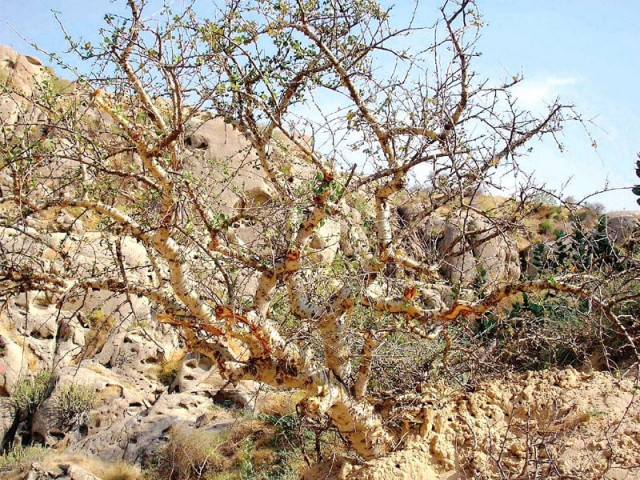Guggul tree: The endangered saviour
A shrub that saves lives finds its own life in danger.

A shrub that saves lives finds its own life in danger. PHOTO: YOUNUS BHANDHANI
In Pakistan, Guggul trees are mainly found in the arid hills of Jamshoro, the Kirthar mountain range and the Thar desert, but grow in some parts of Punjab and Balochistan as well. The resin extracted in Sindh has the highest percentage of Guggulsterone, (a plant steroid used in many nutritional supplements), making it the best that is produced in Asia, says Dr Syed Ghulam Musharraf of the H.E.J. Research Institute of Chemistry, University of Karachi. However, gum production in Pakistan still lags behind compared to, say, that in India where, in the recent past, the demand of 300 tonnes was met by a supply of approximately 75 tonnes, while Pakistan was producing between 25-50 tonnes in 1998.
Until a few years ago poor cattle herders from the Kohli caste would extract resin while pasturing their herds and sell it off in the market to earn their living. But demand for guggul resin skyrocketed, and so did the price. The price of 40 kilogrammes of Guggul gums ranges from Rs20,000 to Rs40,000, depending on the market. This attracted the interest of village influentials and local politicians, who now control and compete for much of the land growing Guggul.

“Nowadays in the desert, one can see markings with flags in areas controlled by influentials. Each color of the flag depicts the area of the influential,” says Younus Bhandani, a social worker in Tharparkar.
Out of fear that herders may still extract resin while pasturing, the village influentials have banned grazing within their encroached land, hence, depriving thousands of residents from even raising their cattle in the wilderness.
According to Dr Kella Lekhraj, provincial coordinator of the Sustainable Land Management Project, initiated by Baanhn Beli — an NGO working on development projects for rural dwellers in Sindh, particularly Tharparker, “these people have developed unscientific and unethical methods to extract resin. After applying cuts on the tree, they sometimes apply horse urine. This action keeps the tree extract flowing to the maximum, but the unnatural treatment leads the tree to its demise in a few years.”
This exacerbates the threats already faced by the Guggul from droughts, overgrazing and termites. As a result, the Guggul has been listed in the IUCN’s Red list for Tharparker division as “Data Deficient”, which means that a survey needs to be conducted to monitor the change in its numbers in the future, reveals Dr Lekhraj.
Some forestry experts suggest adopting a multipronged approach for saving the Guggul tree, such as the electronic mapping of Guggul concentration sites through Geographic Information Systems, appointment of eco-guards from the community, declaring the area protected by law and empowering the district administration to implement Section 144 of the Pakistan’s Code of Criminal Procedure to halt harmful activities to the ecosystem. The experts also advocate sensitising the residents on the enormous benefits of the tree rather than outright banning of activities such as cutting and grazing, which might prove to be far more effective in the long run.
George Sadiq is a member of IUCN Commission on Education and Communication.
Published in The Express Tribune, Sunday Magazine, May 25th, 2014.



















COMMENTS
Comments are moderated and generally will be posted if they are on-topic and not abusive.
For more information, please see our Comments FAQ